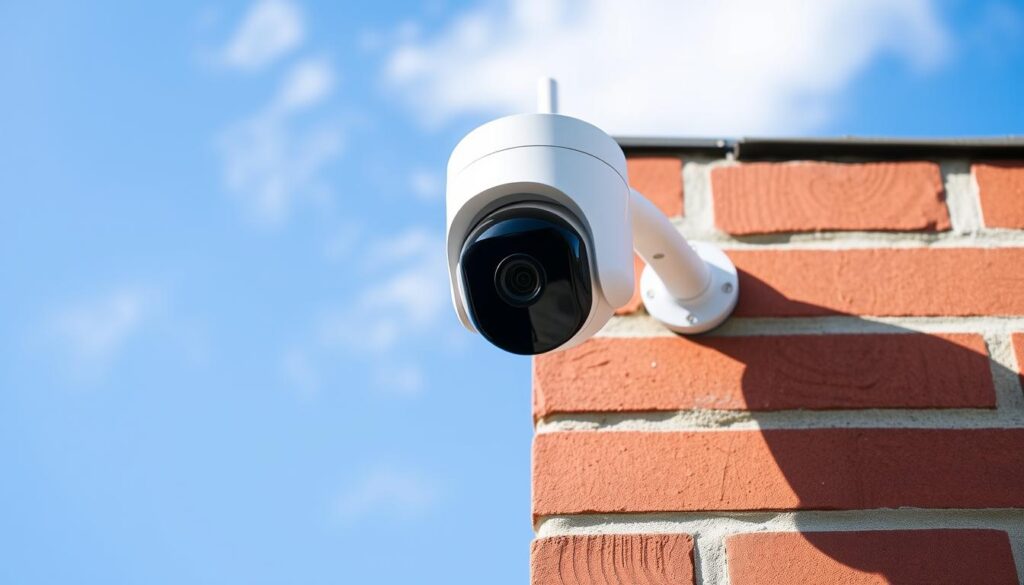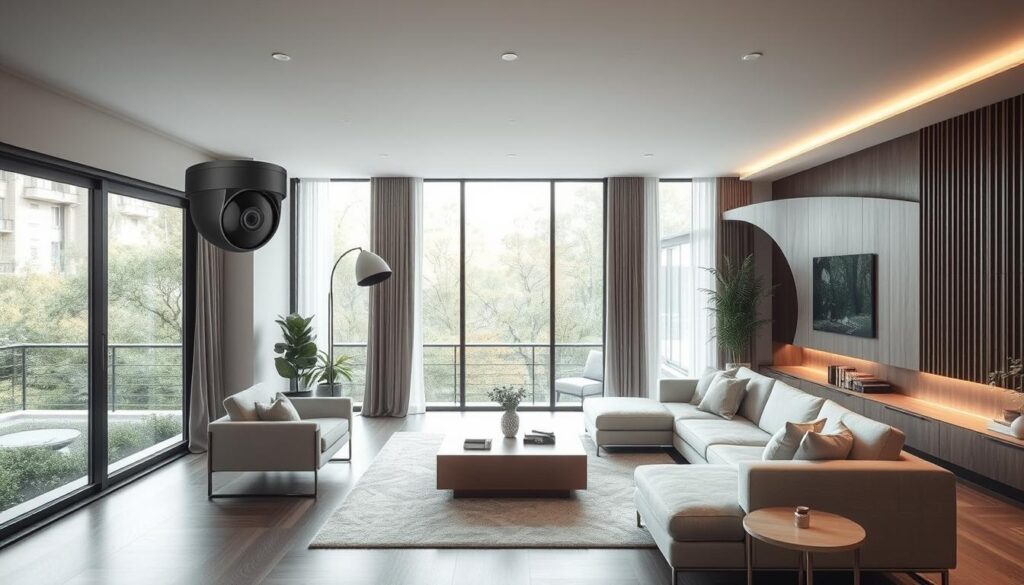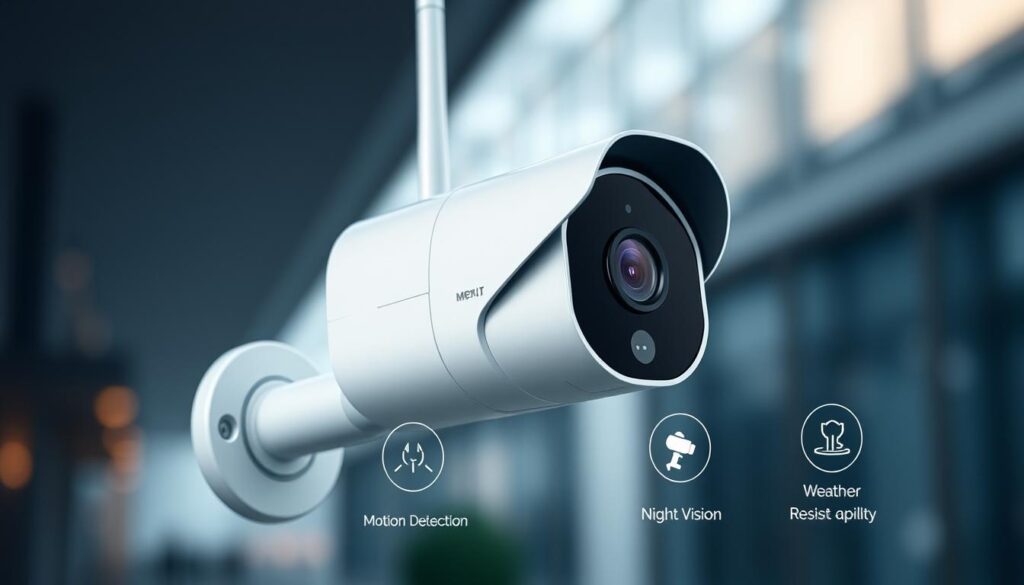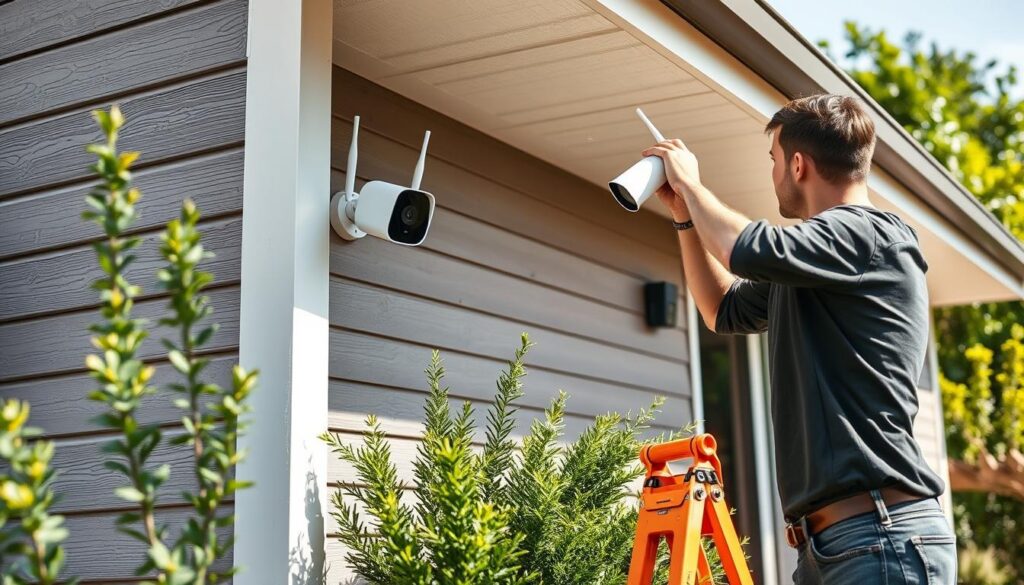Wireless security cameras are now a top pick for homes and businesses. They’re easy to set up and offer lots of flexibility. Thanks to CCTV tech, these cameras work better and give clear video, even at night.
They don’t need wires, which saves time and money. This makes them a great choice for anyone looking to improve security.
These cameras show very clear video, thanks to their high definition. They also have color night vision, which is better than old black-and-white cameras. Plus, they alert you right away if they see motion.

Setting up these cameras is easy, even for DIY experts. They’re weatherproof, so they won’t break down in bad weather. Companies also offer help from picking the right camera to setting it up.
Key Takeaways
- Wireless security cameras offer a convenient and hassle-free way to secure homes and businesses.
- Wireless camera technology provides high-quality video footage and advanced features such as motion detection and night vision.
- Wireless security cameras are designed for simple DIY installation and can be used to enhance home and business security.
- Advanced wireless security systems feature complete weather resistance and support services.
- Wireless security cameras provide ultra-high-definition video and color night vision technology for enhanced visibility.
- Motion detection technology sends instant smartphone alerts for timely responses to possible security issues.
Understanding Wireless CCTV Technology
Wireless CCTV technology has changed how we think about home security and surveillance. It lets us send video and audio over WiFi. This makes setting up and keeping up with surveillance systems much simpler.
Wireless CCTV uses WiFi to send video and audio to a hub or the internet. This means no need for cables. It’s great for places where wires are hard to use.

How Wireless CCTV Works
Wireless security cameras connect to the internet or recorders. This lets homeowners watch their property from anywhere. It adds security and peace of mind.
Key Components of Wireless Systems
A wireless CCTV system has a camera, transmitter, and receiver. The camera captures video and audio. These signals are sent to the receiver over WiFi.
The receiver then connects to a monitor or recorder. This lets users see and save the footage.
Digital vs. Analog Wireless Cameras
Digital cameras give better video quality and resist interference better than analog ones. But, analog cameras are cheaper and easier to set up. Homeowners should think about their needs and budget when choosing.
Knowing how wireless CCTV works helps homeowners pick the best system. Whether for home or business, it keeps you connected and safe.
Benefits of Going Wireless for Home Security
Wireless camera systems make home security easy and flexible. They don’t need cables, so you can move them around easily. This makes them a great choice for homeowners who want to keep their homes safe.
Some of the key benefits of wireless camera systems include:
- Easy installation and relocation
- Flexibility and convenience
- Enhanced home security
- Peace of mind for homeowners and their families
These systems also have cool features like motion detection and night vision. They help keep intruders away and prevent crime. You can get alerts and watch footage from anywhere, so you can act fast if needed.

Wireless camera systems can also save you money over time. They don’t need cables, so installation is cheaper. But, it’s important to think about the downsides like signal problems and hacking risks.
| Feature | Wireless Camera Systems | Wired Camera Systems |
|---|---|---|
| Installation | Easy and flexible | More cumbersome and requires cables |
| Cost | Lower installation cost | Higher installation cost |
| Security | Advanced features such as motion detection and night vision | More stable connection and less susceptible to hacking |
Types of Closed Circuit Cameras Wireless
There are many types of wireless cameras, including indoor and outdoor models. Each has special features for different uses. Indoor cameras are great for places like stores, entrances, and offices. Outdoor cameras are perfect for watching over parking lots and building edges.
Bullet cameras and dome cameras are favorites for outdoor security. They can handle the weather well. Pan-tilt-zoom cameras are flexible and can move to capture more angles.
Solar-powered cameras are also popular. They’re easy to set up and save energy. These are perfect for spots without power, making them great for the outdoors. With so many options, finding the right camera for your needs is easy.
Essential Features to Consider
When picking a wireless security camera, it’s key to look at the must-have features. These features boost the camera’s performance and make it effective for surveillance systems. Key features include motion detection, night vision, and weatherproofing. These allow the camera to spot and record odd activity, even when it’s dark or in bad weather.
Here are some top wireless camera features to think about:
- Motion detection: Warns you of possible dangers and cuts down on false alarms
- Night vision: Lets the camera take clear pictures in dim light
- Weatherproofing: Keeps the camera safe from rain, snow, and extreme heat
Also, don’t forget about the camera’s resolution, field of view, and sound quality. A camera with high resolution, wide field of view, and clear sound gives a better look at what’s happening. It helps spot possible threats more easily.

By looking at these key features, you can pick a wireless security camera that fits your needs. It will offer effective surveillance systems for your home or business.
| Feature | Description |
|---|---|
| Motion Detection | Alerts you to possible dangers and cuts down on false alarms |
| Night Vision | Allows the camera to take clear images in low light |
| Weatherproofing | Keeps the camera safe from rain, snow, and extreme temperatures |
Range and Connectivity Options
When looking at wireless camera range and connectivity, several factors matter. The range shows how far a camera can send signals to a receiver or router. Most cameras can send signals up to 100 feet, but walls and other things can affect this.
To improve range and connectivity, you can use signal boosters and extensions. These tools make the signal stronger, letting it go further and through obstacles. Some systems also let you add more cameras, supporting up to 16 or more.

Wi-Fi Range Specifications
Wi-Fi range varies by camera model and maker. Some can reach up to 100 feet, while others may not go as far. Always check the camera’s specs before buying to make sure it fits your needs.
Network Requirements
Wireless cameras need different networks to work. Some need a strong internet connection, while others work on local networks. Make sure the camera’s network needs match your setup.
Signal Boosters and Extensions
Signal boosters and extensions can boost your camera’s range and connectivity. They make the signal stronger, helping it go further and through obstacles. Some popular options include:
- Wi-Fi range extenders
- Signal amplifiers
- Repeater devices
| Camera Model | Wi-Fi Range | Network Requirements |
|---|---|---|
| Reolink Argus 4 Pro | Up to 100 feet | 2.4GHz Wi-Fi network |
| Arlo Pro 5S | Up to 100 feet | 2.4GHz or 5GHz Wi-Fi network |
| Eufy Solo IndoorCam C120 | Up to 50 feet | 2.4GHz Wi-Fi network |
Video Quality and Resolution Standards
When it comes to wireless camera video quality, resolution standards are key. The resolution of a camera affects how clear the images are. Higher resolutions mean clearer images. Common resolutions include 2MP (1080p), 4MP (1440p), 5MP (1920p), and 8MP (4K/2160p).
The number of pixels in a camera matters a lot. For example, 1080p has 2,073,600 pixels, while 4K has 8,294,400 pixels. This difference in pixels greatly affects the video quality. Aspect ratios also vary, with 1080p and 4K having a 16:9 ratio, and 5MP having a 4:3 ratio.
Some cameras, like the Reolink RLC-510A, offer 5MP resolution and night vision up to 100 feet. The Reolink RLK8-800B4 has 4K Ultra HD cameras and a 2TB HDD for 24/7 recording. These examples show why choosing the right resolution is important.
When it comes to live streaming, a 5MP camera can stream at 1920p, 1440p, and 1080p. A 4MP camera can stream at 1440p, 1080p, and 720p. Both 1440p and 1920p have the same horizontal pixel count (2560 pixels). For general surveillance, 720p and 1080p are common, while 4K is used for detailed monitoring.
Higher resolution cameras mean larger data files, which affects storage. A stable network is also needed for these cameras to stream well. Knowing about resolution standards helps choose the right camera for your needs, ensuring great video quality and surveillance.
Storage Solutions for Wireless CCTV
There are many ways to store video from wireless security cameras. You can choose local storage or cloud storage. Local storage keeps recordings on-site, either in the camera or a central NVR/DVR. It’s easy and doesn’t need the internet. But, it needs regular checks and updates.
Cloud storage is a safe and dependable choice. It uses services like subscription plans with strong security. This way, you can access your recordings from anywhere.

| Storage Method | Advantages | Disadvantages |
|---|---|---|
| Local Storage | No internet needed, more control over privacy | Needs upkeep, can get damaged |
| Cloud Storage | Secure, reliable, easy to access from anywhere | Costs money each month, needs internet |
Choosing between local and cloud storage for wireless CCTV depends on what you need. Both have good points and downsides. Think about how long you want to keep recordings, how much space you need, and how safe it should be.
Installation and Setup Process
The wireless camera installation is easy and doesn’t need much tech know-how. Most people can set it up fast and start watching their space right away. First, you scan a QR code, make a password, and start with the app.
When setting up, pick the right spot, make sure it’s powered well, and adjust the camera’s settings. For best results, hang cameras about 9 feet up to cover more area and prevent tampering. Also, keep them safe from weather.
The setup process might include linking to a network, setting up motion alerts, and more. Many cameras come ready to go, but you might need to tweak some settings for your needs.

Cameras like the Reolink Argus 4 Pro make things easier with their features. They have apps that are easy to use, voice control, and alerts you can customize. These features help you set up your camera fast and start watching your space.
In summary, setting up a wireless camera is made simple and quick. Just follow the instructions and adjust the settings to get a system that works well for you.
Power Sources and Battery Life
There are many ways to power wireless cameras. Battery-powered cameras turn on only when they see movement. This helps them last longer. For instance, the Reolink Argus 4 Pro has a battery that lasts 30% longer than others.
Solar-powered cameras, like the Reolink Argus 3 Ultra, don’t need cables. They work even when the power goes out. PoE cameras make setting up easy. You can power up to 8 cameras with just one Ethernet cable and a PoE switch.
Here’s how long some popular cameras’ batteries last:
| Brand | Average Battery Life |
|---|---|
| Lorex | 6-9 months |
| Ring | 6-12 months |
| Nest | 1-7 months |
| Arlo | 3-6 months |
| Blink | Up to 2 years |
Users of battery cameras can keep an eye on their power use. They get alerts from software to avoid sudden battery drains. PoE cameras solve common power issues, making them great for big setups.
Security and Encryption Protocols
Keeping your wireless camera system safe is key. Encryption protocols like WPA2 and AES help a lot. They make sure your video is only seen by those who should see it.
Encryption protocols have some important features. They include:
- Secure data transmission
- Protection against unauthorized access
- Compliance with industry standards such as IEEE 802.11
Other security steps like strong passwords and safe cloud storage also help.
Using strong encryption and other security steps keeps your system safe. This protects it from threats and breaches.
| Encryption Protocol | Description |
|---|---|
| WPA2 | Provides secure transmission and storage of video footage |
| AES | Ensures that only authorized devices can decode the signal |
Mobile Integration and Remote Access
Wireless camera systems now offer mobile integration and remote access. This lets users check on their property from anywhere. It’s great for those who can’t be there in person.
Users can watch live footage, get alerts, and tweak camera settings with apps. This makes it easy and convenient. Some top choices for remote access include:
- Smartphone apps for iOS and Android devices
- Desktop applications for Windows and Mac computers
- Web-based interfaces for remote viewing and camera control
When picking a wireless camera system, think about remote access. Make sure it’s secure and easy to use. Look for systems with good mobile apps and interfaces.

In summary, wireless camera systems with mobile integration and remote access are very useful. They offer flexibility and peace of mind. By choosing a system with reliable remote access, you can keep your property safe and monitored.
| Feature | Description |
|---|---|
| Remote Viewing | Access live footage and adjust camera settings remotely |
| Mobile Apps | Control cameras and receive notifications using smartphone apps |
| Desktop Applications | Access and control cameras using desktop applications |
Maintenance and Troubleshooting
Regular wireless camera maintenance is key for top performance and security. Make sure the camera’s power and connection are good. Also, check the IP address is right. Troubleshooting common problems, like connectivity issues and video loss, can be done by restarting the camera and checking the network.
Some common problems include flickering or distorted video. This might be due to electrical interference or not enough power. Keeping cables tidy is also important to avoid interference and ensure clear video. Adjusting white balance settings can also improve video quality and fix color issues.
To fix wireless camera problems, start with the basics:
- Check the camera’s power and connection
- Verify the IP address and network connection
- Restart the camera and wait 10-20 seconds before turning it back on
- Look for loose or frayed cables and manage them well
By following these steps and doing regular wireless camera maintenance, you can keep your cameras working right. They’ll provide the security and surveillance you need. If problems don’t go away, look at the manufacturer’s guide or call their tech support for help.
| Issue | Cause | Solution |
|---|---|---|
| Flickering or distorted video | Electrical interference or inadequate power supply | Check power supply and cable management |
| Connectivity problems | Incorrect IP address or network connection | Verify IP address and network connection |
| Video loss | Camera malfunction or incorrect settings | Restart camera and check settings |
Cost Considerations and Budget Planning
When you’re looking at wireless camera systems, the wireless camera cost is key. Prices can start at $30 and go up to over $500 for top models. It’s important to think about both the upfront cost and ongoing expenses like storage and monitoring fees.
Good budget planning helps you find a system that fits your security needs without overspending. For example, the Wyze Cam costs about $35.98, while the Vivint outdoor camera can be up to $399. Don’t forget about professional installation costs, which can be between $100 and $200.
Here’s a quick look at some estimated costs:
- Security camera prices: $30 to $500
- Professional installation fees: $100 to $200
- Cloud storage subscription fees: $10 to $50 per month

By looking at these costs and what you need, you can plan your budget well. This way, you’ll make the most of your wireless camera system.
Smart Home Integration Options
Wireless camera smart home integration is key in today’s home security. It lets homeowners link their cameras with smart devices for a full security package. This integration brings voice control, motion alerts, and easy monitoring.
Benefits include live surveillance, quick alerts, and smart automation. For example, Amazon Alexa and Google Home can control your cameras with voice. Plus, smart homes save energy with automated alerts.

- Amazon Alexa
- Google Home
- Z-Wave
These systems offer voice control, motion detection, and save energy. Linking wireless cameras with these systems makes security easy and convenient.
In summary, wireless camera smart home integration is vital for modern security. It brings many benefits like live monitoring, quick alerts, and smart control. As smart home tech grows, we’ll see even more ways to integrate.
Legal Considerations and Privacy Guidelines
Understanding the laws around wireless cameras is key. In the U.S., 15 states have their own rules. Some cities and counties have different laws too. Residential regulations and commercial requirements can change a lot, so knowing your local laws is important.
In places like Florida, Alabama, and Minnesota, hidden cameras are okay in public areas. But in Tennessee, Michigan, and Utah, you need permission to use them in private spots.
To follow the rules, consider these steps:
- Check local laws and regulations regarding security cameras
- Obtain consent from individuals being recorded, if required
- Post clear signage about surveillance to inform individuals of possible recording
By following these steps, you can use wireless cameras effectively and respect people’s privacy.
Future of Wireless CCTV Technology
The wireless CCTV future looks bright, thanks to technology advancements. These include artificial intelligence, machine learning, and cloud computing. These innovations will make wireless security cameras work better and more efficiently.
Several trends are set to influence the wireless CCTV future. These include:
- More use of cloud-native systems and AI for video analysis
- Focus on edge computing to speed up video processing
- IoT networks for quicker HD data transfers and easier management
As technology advancements keep pushing the limits, we’ll see even more features. Expect better video analysis and stronger security. The wireless CCTV future is full of promise, and it will be exciting to see what’s next.
Conclusion
Wireless security cameras are a great way to boost home and business safety. They come with cool features like motion detection and night vision. Plus, you can access them from anywhere, making them super convenient.
These cameras are easy to set up and don’t cost a lot. They also offer better surveillance than old systems. As tech gets better, we’ll see even more awesome features in security cameras.
If you want to protect your home or business, getting a top-notch wireless security camera is smart. Keep up with new tech and think about what you need. This way, you’ll find the best camera for your security needs and feel safe.
FAQ
What is the purpose of this article on closed circuit cameras wireless?
This article introduces closed circuit cameras wireless. It talks about their benefits and importance in today’s surveillance. We’ll cover their technology, features, and uses.
How does wireless CCTV technology work, and what are its key components?
We’ll dive into wireless CCTV technology. We’ll explain how it works and its main parts. You’ll learn about digital and analog cameras, their pros and cons, and the types of systems available.
What are the benefits of using wireless security cameras for home security?
Using wireless security cameras for home security has many benefits. They’re easy to install and offer flexibility. They help keep your home safe, giving you peace of mind.
What types of wireless security cameras are available, and what are their features and applications?
There are many types of wireless security cameras. We’ll look at indoor and outdoor cameras, and pan-tilt-zoom cameras. We’ll talk about their features and uses.
What are the essential features to consider when choosing a wireless security camera?
When picking a wireless security camera, consider key features. Look for motion detection, night vision, and weatherproofing. These features are important for effective surveillance.
What factors affect the range and connectivity of wireless security cameras, and how can they be improved?
The range and connectivity of wireless cameras depend on several factors. We’ll discuss how to improve them. This includes using signal boosters and extensions.
What video quality and resolution standards are available for wireless security cameras?
Wireless security cameras come in different video quality and resolution standards. We’ll look at 720p, 1080p, and 4K. We’ll talk about their uses in various settings.
What storage solutions are available for wireless security cameras, and how do they compare?
There are several storage solutions for wireless security cameras. We’ll explore cloud, local, and hybrid storage. We’ll discuss their pros and cons and how to choose the best one.
How do you install and set up wireless security cameras?
Installing and setting up wireless security cameras is easy. We’ll provide tips for a smooth process. This includes how to ensure they work well and securely.
What are the power source and battery life considerations for wireless security cameras?
We’ll talk about the power sources and battery life of wireless cameras. This includes wireless, battery, and solar options. We’ll discuss their advantages and how to choose the right one.
How are the security and encryption protocols used in wireless security cameras important for protecting video footage?
Security and encryption protocols are key for protecting video footage. We’ll look at WPA2 and AES encryption. We’ll discuss their importance in keeping footage safe.
What mobile integration and remote access capabilities do wireless security cameras offer?
Wireless security cameras offer mobile integration and remote access. We’ll explore smartphone apps, desktop applications, and remote viewing. We’ll discuss their advantages and how to choose the right one.
How do you maintain and troubleshoot wireless security cameras?
Maintaining and troubleshooting wireless cameras is important. We’ll provide tips for keeping them in good condition. This includes how to fix common issues like connectivity problems.
What are the cost considerations and budget planning factors for wireless security cameras?
The cost of wireless security cameras is a key consideration. We’ll discuss the initial cost, ongoing expenses, and service plans. We’ll help you choose the right camera for your budget.
How can wireless security cameras be integrated with smart home systems?
Wireless security cameras can be integrated with smart home systems. We’ll explore options like Amazon Alexa and Google Home. We’ll discuss their benefits and how to integrate them.
What legal considerations and privacy guidelines should be taken into account when using wireless security cameras?
Using wireless security cameras raises legal and privacy concerns. We’ll discuss regulations and laws. We’ll provide guidance on how to comply with them.
What is the future of wireless CCTV technology, and what advancements can be expected?
The future of wireless CCTV technology looks promising. We’ll discuss expected advancements and their applications. This includes better video analytics and enhanced security features.